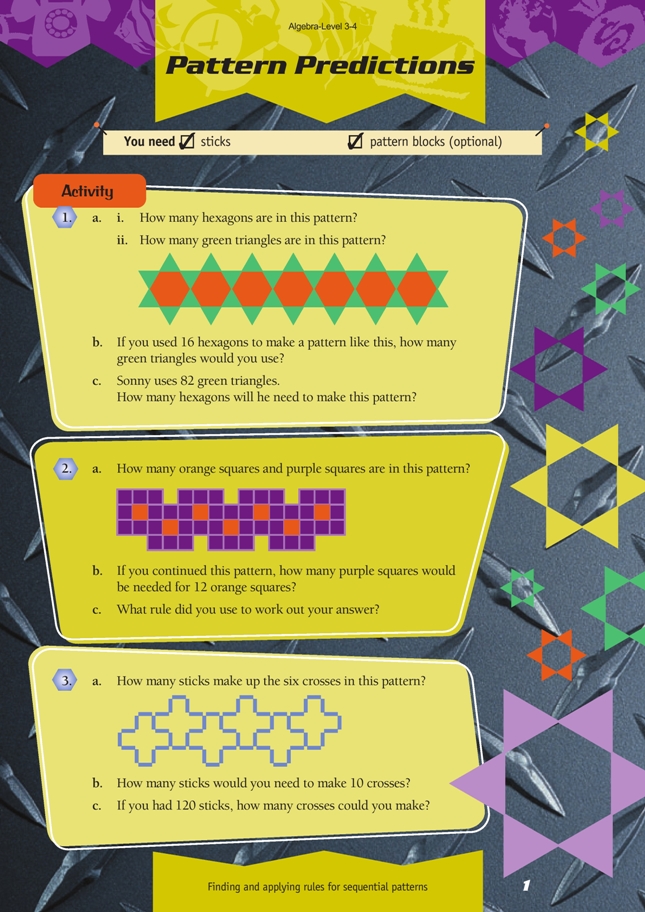This is a level 3 algebra strand activity from the Figure It Out series.
A PDF of the student activity is included.
Click on the image to enlarge it. Click again to close. Download PDF (391 KB)
find and apply rules for sequential patterns
sticks
FIO, Level 3-4, Algebra, Pattern Predictions, page 1
pattern blocks (optional)
In question 1, the students must focus on the relationship between the number of hexagons and the number of triangles. To answer question 1b, they will need to establish a rule for the number of green triangles used in relation to the number of hexagons. Then they can determine the triangles needed for different numbers of hexagons.
If the first hexagon stood alone, it would have six green triangles surrounding it. The next hexagon needs only four new green triangles because it shares two green triangles with the first hexagon.
So a general rule for this problem would be:
Green triangles needed = number of hexagons x 4 + 2 (for the first hexagon).
So for 16 hexagons, you need 16 x 4 + 2 = 66 triangles, and so on.
The students could approach question 2 in the same way as question 1. However, question 2 does provide a good opportunity for levels 3–4 students to use tables to organise results and to look for patterns.
Some students may use spatial knowledge to solve the problem in the following way: Each 3 x 3 square within the pattern is made up of nine tiles. One square is orange, which means that eight squares are purple. Two purple squares are “lost” with each join, so 8 – 2 = 6 purple squares are added with each new orange square.
Although such reasoning is powerful and contains important skills involving spatial visualisation, it is also difficult. A numeric approach might be to organise the results in a table as the pattern is built up with tiles:
In doing this, the students may see the “growing by six” pattern of the numbers of orange squares. A level 3 strategy would be either to continue the table by adding sixes along the bottom row of the table or to write an adding expression such as 8 + 6 + 6 + 6 + 6 + 6 …
Questions such as “Is there a quicker way to add up all those sixes?” will help the students to focus on the link between repeated addition and multiplication. This is a critical understanding about the processes of arithmetic that the students must acquire in order to use level 4 strategies, which in this case, for 12 orange squares, could be: “11 x 6 = 66, and I add on 8 for the first square. That means 12 orange squares will have 74 purple squares.”
Whichever strategy they use, the students should be able to come up with a rule such as: purple squares = 6 x the number of orange squares + 2.
An important idea in this activity is the reversal of rules, which may involve applying inverse operations. For example, in question 3, students are asked how many crosses they could make with 120 sticks. The previous questions encouraged the students to develop some form of rule.
The students working at level 3 may use the following method:
The students at this level may simply continue to add nines until 120 sticks are reached and the corresponding number of crosses is found. However, if you look at a rule with them, it could be written as: sticks needed = 9 x the number of crosses + 3.
The students working at level 4 may use multiplicative rules to find how many sticks were needed for 10 crosses. For example:
Encourage the students to use their knowledge of arithmetic to solve the problems. They will probably come up with answers such as:
“I knew that 10 crosses needed 93 sticks, so I tried some numbers between 10 and 20.”
“15 times 9 is 135 and 3 more is 138, so 15 crosses was too many.”
“120 sticks was 27 more. 3 times 9 is 27, so there were 3 more crosses.”
To encourage the students to reverse their rules, increase the number of sticks so that “trial and improvement” strategies become less profitable. For example, “246 sticks. How many crosses?” As an equation, this is x 9 + 3 = 246. The students can reverse this by subtracting 3 from each side to give x 9 = 243. They can then divide 243 by 9 to find the answer, 27.
Answers to Actvity
1. a. i. 7
ii. 30
b. 66
c. 20
2. a. 7 orange and 44 purple
b. 74
c. A likely rule is: 6 x number of orange squares + 2. A “+ 6” rule (that is, 8 + 6 + 6 + 6 ...) is less powerful.
3. a. 57
b. 93
c. 13



